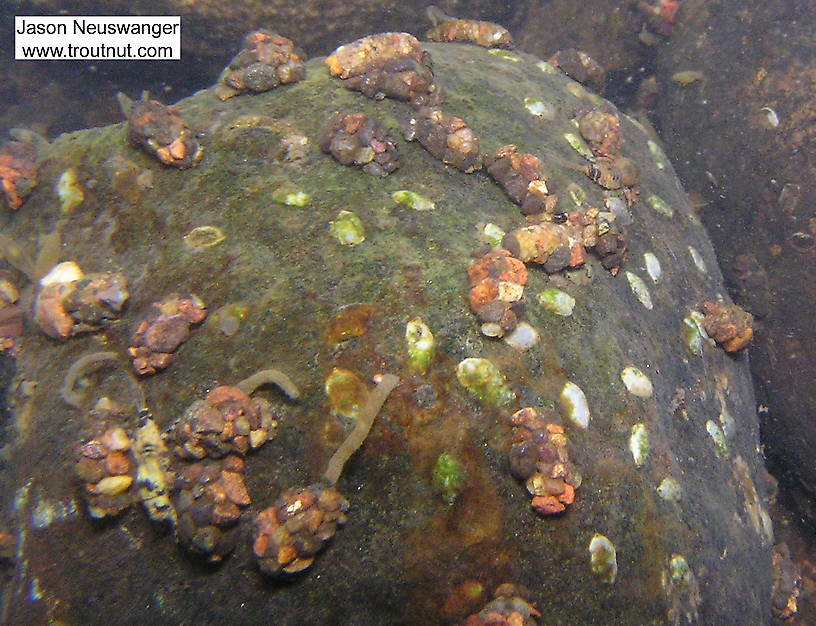Blog & Latest Updates
Fly Fishing Articles
Insects by Common Name


Caddisfly Family Hydroptilidae (Microcaddisflies)
Taxonomic Navigation -?-
Kingdom
Animalia (Animals)
» Phylum
Arthropoda (Arthropods)
» Class
Insecta (Insects)
» Order
Trichoptera (Caddisflies)
» Family Hydroptilidae (Microcaddisflies)
| Genus in Hydroptilidae | ||
| AgrayleaSalt and Pepper Microcaddisflies | 0 | 0 |
| HydroptilaVaricolored Microcaddisflies | 1 | 1 |
| LeucotrichiaRing Horn Microcaddisflies | 0 | 2 |
| OxyethiraCream and Brown Microcaddisflies | 0 | 0 |
11 genera aren't included.
Common Name
| Match | Common Name |
| Microcaddisflies |
Like the Tricorythodes mayflies, Microcaddisflies can be important to trout because of their extreme abundance in certian waters.
Hatching Behavior
Pupae emerge on the surface, where they struggle for a long time to break through.
Egg-Laying Behavior
Females dive to the bottom to lay their eggs.
Larva & Pupa Biology
Diet: Plankton or algae (including filamentous)
Shelter Type: Plant matter, rock, sand, or silk
Hydroptilidae larvae don't build cases until their fifth and last instar (Instar: Many invertebrates molt through dozens of progressively larger and better-developed stages as they grow. Each of these stages is known as an instar. Hard-bodied nymphs typically molt through more instars than soft-bodied larvae.), although they do speed through the first four instars (Instar: Many invertebrates molt through dozens of progressively larger and better-developed stages as they grow. Each of these stages is known as an instar. Hard-bodied nymphs typically molt through more instars than soft-bodied larvae.) in the first two weeks of their lives. In the fifth instar (Instar: Many invertebrates molt through dozens of progressively larger and better-developed stages as they grow. Each of these stages is known as an instar. Hard-bodied nymphs typically molt through more instars than soft-bodied larvae.), their abdomens grow proportionally huge and they build flat cases from a variety of materials. Leucotrichia pictipes, for example, builds oval silk cases which at first are not recognizable as caddis cases at all to anyone not familiar with the species.Shelter Type: Plant matter, rock, sand, or silk
Pictures of 1 Caddisfly Specimen in the Family Hydroptilidae:
Hydroptila (Varicolored Microcaddisflies) Caddisfly Nymph View 1 Pictures
View 1 Pictures
 View 1 Pictures
View 1 PicturesCollected April 8, 2005 from the Flathead River-Upper in Montana
Added to Troutnut.com by Bnewell on June 27, 2011
Added to Troutnut.com by Bnewell on June 27, 2011
2 Underwater Pictures of Hydroptilidae Caddisflies:

The white blotches on this rock are Leucotrichia caddisfly cases, and the wispy tubes are cases made by a type of midge.
In this picture: Mayfly Species Ephemerella invaria (Sulphur Dun), Caddisfly Species Leucotrichia pictipes (Ring Horn Microcaddis), and True Fly Family Chironomidae (Midges).
In this picture: Mayfly Species Ephemerella invaria (Sulphur Dun), Caddisfly Species Leucotrichia pictipes (Ring Horn Microcaddis), and True Fly Family Chironomidae (Midges).
StateWisconsin
LocationNamekagon River
Date TakenMar 24, 2004
Date AddedJan 25, 2006
AuthorTroutnut
CameraOlympus C740UZ

There's a stonefly nymph in the bottom right corner of this picture, but what's really interesting is those white blotches. They're pretty common in my Wisconsin home river river, stuck flat onto the rocks--lots of rocks have a speckled look as a result. They are microcaddis cases, made by larvae of the caddisfly family Hydroptilidae. These are made by larvae of the subfamily Leucotrichiinae, most likely the genus Leucotrichia. They spin little flat oval cases of silk tight and immobile against the rocks.
In this picture: Caddisfly Species Leucotrichia pictipes (Ring Horn Microcaddis).
In this picture: Caddisfly Species Leucotrichia pictipes (Ring Horn Microcaddis).
StateWisconsin
LocationNamekagon River
Date TakenMar 20, 2004
Date AddedJan 25, 2006
AuthorTroutnut
CameraOlympus C740UZ
Recent Discussions of Hydroptilidae
Tiny Black Caddis hatch, late fall - Nov 26 to be exact_ Spring Creek Southern MO 21 Replies »
I had not fished Bennett Spring for many years and ended up there on Nov 26. I was not very prepared for the stream's entemology, spoke to someone at the flyshop and went with fishing a midge or two and this was very successful. But it was quite obvious that the trout were feeding on the surface or just under and it wasn't a midge. As the day progressed and late afternoon brought sunshine, a hatch of Tiny Caddis(Black) appeared. I had a size 18 but it wasn't dark enough or small enough. A gent who fished the stream regularly gave me a #24 black Elk Hair(or other hair) caddis. The fish took this fly as a dry off the surface. I am hard pressed to ID this fly aside from Protoptila. This, however, is not a marginally temp spring, the water is consistent flow a cold. The description of the Protoptila indicates that this insect is more a warm water insect. The hatch was occurring right at the spring itself. Any ideas?
Again, this was a size 24 fly, and maybe,just maybe, a 26 or 28 might have been the appropriate size for the insect as there were obvious refusals at the surface.
David (dai_sca@yahoo.com
ReplyAgain, this was a size 24 fly, and maybe,just maybe, a 26 or 28 might have been the appropriate size for the insect as there were obvious refusals at the surface.
David (dai_sca@yahoo.com
There are 1842 more topics.
Your Thoughts On Hydroptilidae:
Top 10 Fly Hatches
Top Gift Shop Designs
Eat mayflies.
Top Insect Specimens
Miscellaneous Sites
Troutnut.com is copyright © 2004-2024 Jason
Neuswanger (email Jason). See my FAQ for information about use of my images.
 privacy policy
privacy policy
